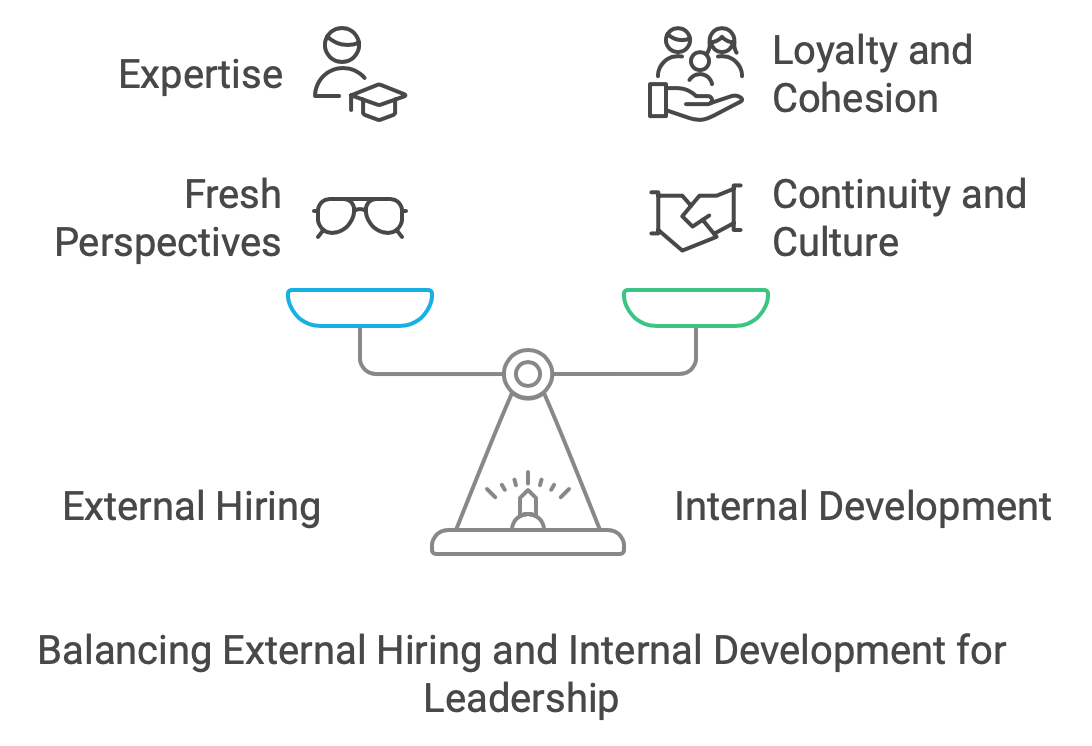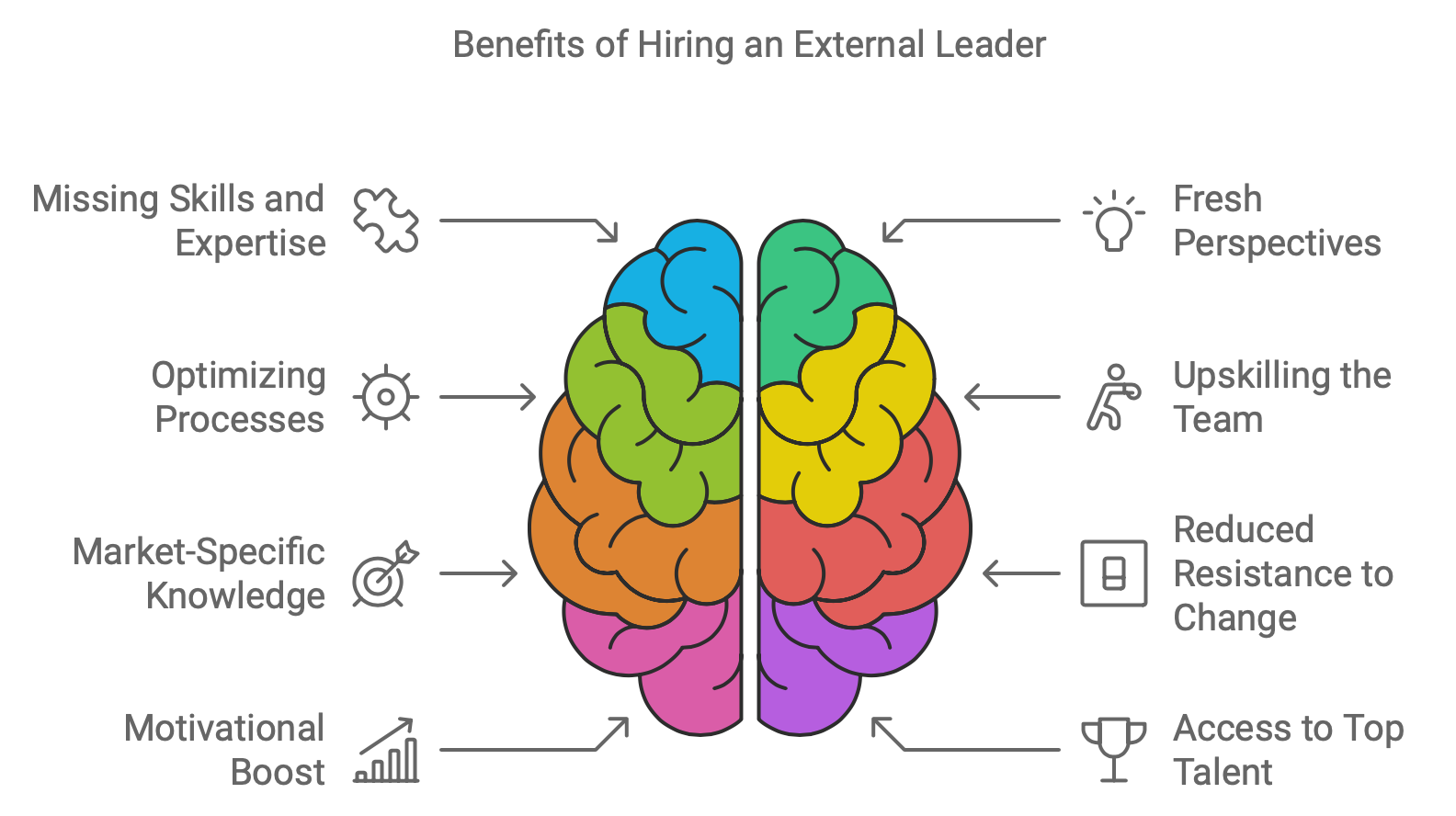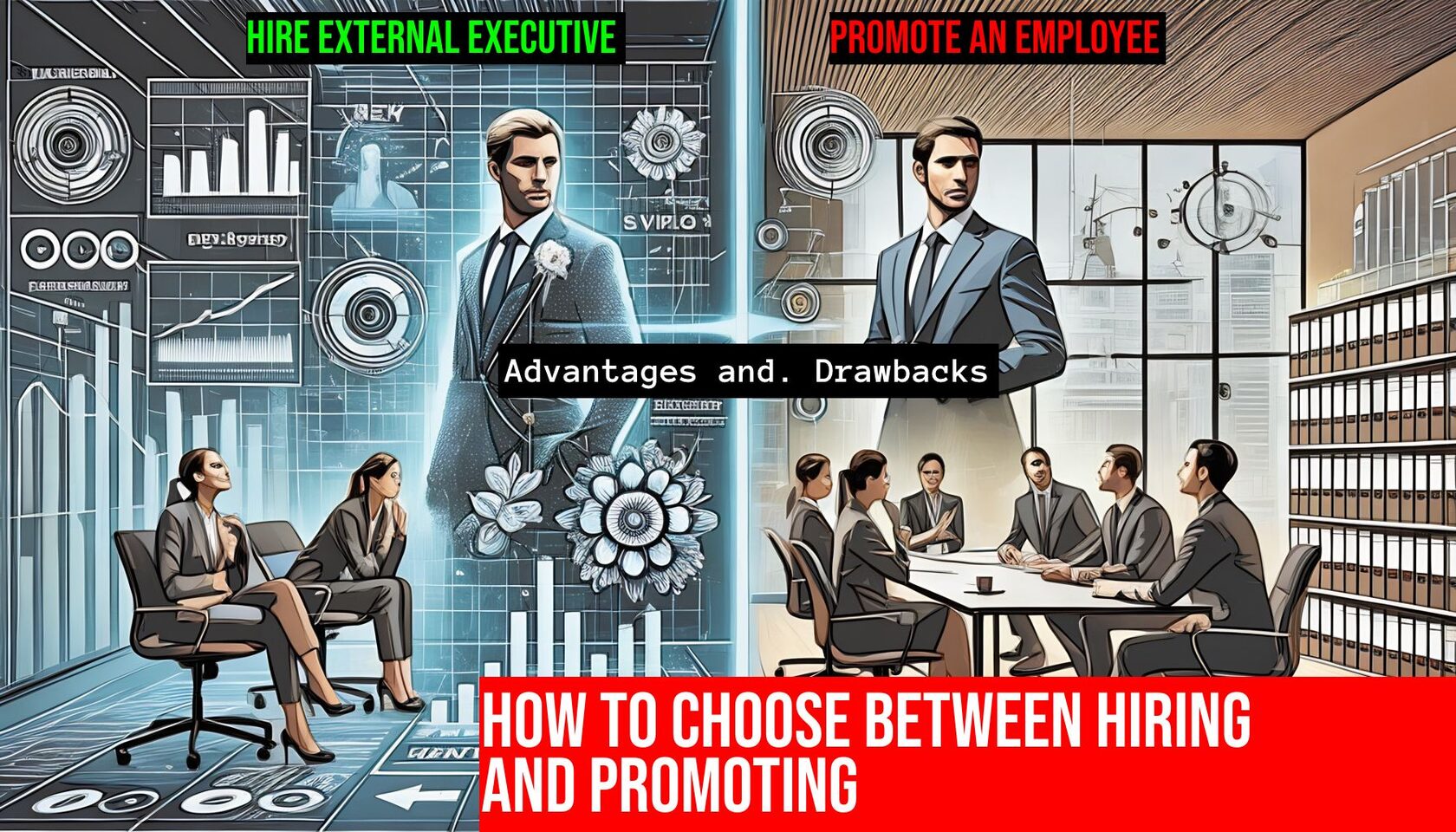Hiring or Developing? Finding the Best Source for Leadership
The talent shortage in today’s market affects not only frontline employees but also top executives and management. Finding experienced leaders is not only challenging but also costly. So, when is it more beneficial to hire an external leader, and when is it better to cultivate talent from within the company? Let's explore this dilemma.

Both approaches have their merits, and the best choice depends on the specific context of your company. In dynamic and fast-growing industries, external hires bring fresh perspectives and much-needed expertise. However, if your organization values continuity and culture, promoting from within can foster a strong sense of loyalty and cohesion. Ultimately, striking the right balance between external and internal talent development is key to building a resilient and adaptive leadership team.
When to Hire from the Outside

The biggest advantage of hiring an external leader is bringing in the missing skills and expertise that your team may lack. If you find a leader with unique and relevant experience, they can introduce fresh perspectives, optimize processes, and upskill your team in ways that may not be possible with internal resources.
For example, let’s say a company wants to expand into the Middle Eastern market. If the current leadership lacks experience in this region, an external hire with deep knowledge of the market can step in and lead this new initiative. Since this leader is starting with a clean slate, the team is often less resistant to the change, reducing friction during the transition.
An additional benefit of hiring externally is the motivational boost it can provide to the existing team. A capable leader from outside the organization often sets a high standard, inspiring employees to push their own boundaries and develop their skills further. This can result in increased productivity and growth for the team.
Moreover, hiring externally allows you to tap into the best talent on the market. By bringing in someone with superior knowledge and experience, your company gets the opportunity to work with top-tier professionals, which can significantly elevate the entire team’s performance. If you are a founder of a Start Up or Scale Up, you have no other choice - 5 Hiring Hacks Every Founder Needs to Attract Top Talent Fast.
For example, let’s say a company wants to expand into the Middle Eastern market. If the current leadership lacks experience in this region, an external hire with deep knowledge of the market can step in and lead this new initiative. Since this leader is starting with a clean slate, the team is often less resistant to the change, reducing friction during the transition.
An additional benefit of hiring externally is the motivational boost it can provide to the existing team. A capable leader from outside the organization often sets a high standard, inspiring employees to push their own boundaries and develop their skills further. This can result in increased productivity and growth for the team.
Moreover, hiring externally allows you to tap into the best talent on the market. By bringing in someone with superior knowledge and experience, your company gets the opportunity to work with top-tier professionals, which can significantly elevate the entire team’s performance. If you are a founder of a Start Up or Scale Up, you have no other choice - 5 Hiring Hacks Every Founder Needs to Attract Top Talent Fast.
Potential Drawbacks of External Hiring
However, hiring externally does come with risks. One major concern is the potential negative reaction from the team. A new leader can be met with resistance for various reasons—personal dislike, fear of change, or simply the disruption that any new authority brings. It’s important to recognize that an external hire, especially in a leadership role, can be a source of stress for employees.
When promoting from within, you already understand the person’s work style, strengths, and weaknesses. With an external hire, these are unknown factors. Employees will need time to adjust to the new leader’s personality, management style, and communication methods, which could cause tension.
There is also the risk that the new leader won’t mesh well with the existing team, leading to potential turnover if they attempt to restructure the department. To mitigate this, consider placing limitations on decision-making in the first few months. For example, agree that the new leader should not make any staffing changes within the first three months. Also, make sure onboarding is thorough—this can significantly reduce the number of issues that arise with external hires.
Another important consideration is the time it takes for the new leader to get up to speed. It can take up to six months for an external manager to fully adapt to the company culture, processes, and expectations, meaning that any noticeable results may take time - Building Success from Day One: A CEO's Guide to Effective Employee Onboarding
Finally, cost is a factor. External hires are often significantly more expensive, especially if they have an impressive track record and portfolio. Companies should weigh whether the benefits of an outside leader justify the higher cost.
When promoting from within, you already understand the person’s work style, strengths, and weaknesses. With an external hire, these are unknown factors. Employees will need time to adjust to the new leader’s personality, management style, and communication methods, which could cause tension.
There is also the risk that the new leader won’t mesh well with the existing team, leading to potential turnover if they attempt to restructure the department. To mitigate this, consider placing limitations on decision-making in the first few months. For example, agree that the new leader should not make any staffing changes within the first three months. Also, make sure onboarding is thorough—this can significantly reduce the number of issues that arise with external hires.
Another important consideration is the time it takes for the new leader to get up to speed. It can take up to six months for an external manager to fully adapt to the company culture, processes, and expectations, meaning that any noticeable results may take time - Building Success from Day One: A CEO's Guide to Effective Employee Onboarding
Finally, cost is a factor. External hires are often significantly more expensive, especially if they have an impressive track record and portfolio. Companies should weigh whether the benefits of an outside leader justify the higher cost.
Developing Internal Leaders

On the other hand, developing leadership from within the company is often more cost-effective. These individuals already understand and embrace the company’s values and culture, so you don’t need to invest as much time in getting them up to speed.
Internal leaders are also more deeply involved in current workflows, which can allow them to transition into new roles without a significant dip in performance. Their familiarity with the team’s strengths and weaknesses can make delegation and task management smoother, while also helping to minimize potential conflicts.
Having a system that nurtures leadership from within can also enhance your employer brand. Employees are more engaged when they know there is a clear path for career progression. This not only boosts retention but also attracts top talent to your organization, as people want to work in environments where they see opportunities for growth. Empowering Employees Through Learning: How Skill Development Drives Loyalty and Retention
Another advantage of this approach is flexibility. Internal talent development enables a higher degree of interchangeability among employees. If someone goes on leave or unexpectedly resigns, there’s often someone within the company ready to step up, saving time and resources that would otherwise be spent on hiring and onboarding a replacement. Imaging you're about to lead army into a battle
Internal leaders are also more deeply involved in current workflows, which can allow them to transition into new roles without a significant dip in performance. Their familiarity with the team’s strengths and weaknesses can make delegation and task management smoother, while also helping to minimize potential conflicts.
Having a system that nurtures leadership from within can also enhance your employer brand. Employees are more engaged when they know there is a clear path for career progression. This not only boosts retention but also attracts top talent to your organization, as people want to work in environments where they see opportunities for growth. Empowering Employees Through Learning: How Skill Development Drives Loyalty and Retention
Another advantage of this approach is flexibility. Internal talent development enables a higher degree of interchangeability among employees. If someone goes on leave or unexpectedly resigns, there’s often someone within the company ready to step up, saving time and resources that would otherwise be spent on hiring and onboarding a replacement. Imaging you're about to lead army into a battle
Drawbacks of Internal Development
That said, promoting from within is not without its challenges. One of the biggest is the difficulty employees may face when transitioning from peer to manager. It can be awkward and uncomfortable to suddenly oversee colleagues you’ve worked alongside for years. Delegating tasks and setting expectations can become a source of friction if the team isn’t fully prepared for the change.
These internal dynamics can lead to burnout for the new manager, as they struggle to balance relationships and responsibilities. To avoid this, it’s critical to prepare both the future leader and the team for the transition. Continuous Learning and Leadership Coaching: Unlock Your Potential with UnitiQ
It’s also important to recognize that not every employee is suited for leadership. Some may lack the discipline, autonomy, or interpersonal skills needed to effectively manage a team. This is why it's essential to be selective and focus on employees who not only show potential but are also eager for leadership roles.
These internal dynamics can lead to burnout for the new manager, as they struggle to balance relationships and responsibilities. To avoid this, it’s critical to prepare both the future leader and the team for the transition. Continuous Learning and Leadership Coaching: Unlock Your Potential with UnitiQ
It’s also important to recognize that not every employee is suited for leadership. Some may lack the discipline, autonomy, or interpersonal skills needed to effectively manage a team. This is why it's essential to be selective and focus on employees who not only show potential but are also eager for leadership roles.
Conclusion: To Hire or to Develop?
The decision to hire externally or develop internal talent should be based on your company’s specific needs and long-term goals. If you're seeking fresh ideas and specialized expertise, an external hire may bring the innovation and skills necessary for growth. On the other hand, promoting from within fosters continuity, strengthens company culture, and motivates your team. Balancing these approaches is key to building a resilient and adaptive leadership team.
At UnitiQ, we understand that leadership development is not a one-size-fits-all solution. That’s why we offer services like Fractional CHRO, which provides flexible and expert HR management, as well as the Development of People Strategy to align leadership growth with your business objectives. For companies needing immediate leadership solutions, our Interim Executive Hiring service ensures that you find the right leader who can deliver results quickly. Whether you're building from within or bringing in new talent, UnitiQ is here to guide you every step of the way. Learn advantages of Fractional HR.
Contact me directly:
My Telegram and LinkedIn Profiles.
At UnitiQ, we understand that leadership development is not a one-size-fits-all solution. That’s why we offer services like Fractional CHRO, which provides flexible and expert HR management, as well as the Development of People Strategy to align leadership growth with your business objectives. For companies needing immediate leadership solutions, our Interim Executive Hiring service ensures that you find the right leader who can deliver results quickly. Whether you're building from within or bringing in new talent, UnitiQ is here to guide you every step of the way. Learn advantages of Fractional HR.
Contact me directly:
My Telegram and LinkedIn Profiles.
